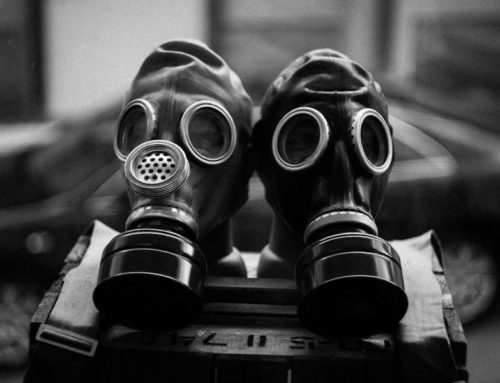The concept of environmental toxins is nothing new. Most of you are already aware of the dangers: We’re constantly being bombarded by pollutants such as chemicals, heavy metals, and parasites nearly everywhere we go and in everything we do, and that disrupts our overall health. But there is a group of chemicals that are particularly malicious and menacing:
Endocrine-disrupting chemicals (EDCs)
EDCs are primarily man-made and can be categorized as industrial chemicals, metals, pesticides, polymers (e.g. nylon, PVC), synthetic estrogens and androgens (e.g. birth control and steroids), pharmaceuticals, and the like. (1)
People come in contact with these nefarious substances throughout various aspects of their lives, such as their jobs, home and garden upkeep, military service, personal care routines, or the use of consumer products. They are exposed by absorbing the chemicals through the skin, breathing them in, or ingesting them via their food and water. (1, 2, 3)
Some groups of people tend to have greater risks of exposure, and others may be more susceptible to developing negative health effects once exposed. Those who work as cleaners, farmers, hairdressers, painters, or textile workers tend to be exposed to higher levels of EDCs. (2)
Although these chemicals are always dangerous, people are especially vulnerable at certain periods, including during childhood, early or prenatal development, menopause, pregnancy, puberty, or when breastfeeding. (1, 2, 3)
EDCs are found in a range of everyday items, including canned goods, cleaning products, cookware and other kitchen items, cosmetics, drinking water, flame retardants, fragranced goods, medications, paint, pesticides, plastics, and water bottles, just to name a few. There are at least 1,500 EDCs in the environment now, and with over 84,000 different chemicals used in the U.S. alone, surely more are coming. (1, 2, 3, 4)
The Endocrine System and EDCs
The reason that EDCs are so troublesome is that they mess with the body’s endocrine system: They block, imitate, and interfere with our hormones. The endocrine system is made up of glands that produce our hormones, which are chemical messengers that regulate our bodily functions. The endocrine system includes the: (1)
- Adrenal glands
- Hypothalamus
- Ovaries or testes
- Pancreas
- Parathyroid
- Pineal gland
- Pituitary gland
- Thymus
- Thyroid
Specific receptors throughout our body receive the endocrine system’s hormonal messengers and perform accordingly. But when EDCs get in the way, the signals are blocked, and the body doesn’t know how to react. When that occurs, things start to go wrong. (1)
This can result in certain cancers, cognitive deficits, developmental problems, disorders of the reproductive system, fertility problems, immune system dysfunction, metabolic diseases (e.g. diabetes), obesity, thyroid problems (e.g. Hashimoto’s disease), and more. (1, 3)
The endocrine system is kind of like the puppet master of our bodies. It oversees or controls virtually everything our bodies do, including energy balance, growth and development, mood, metabolism, organ function, reproduction, and regulation of body weight. (1)
That means that when EDCs ambush our endocrine system, they are really getting us where it hurts. It is a little bit like attacking the leader of a country or killing the queen bee. EDCs assault us in a way that really undermines our defenses and causes us maximum harm.
EDCs differ from many other toxins for several reasons. First, they are dangerous even at low doses. But, naturally, they are even more dangerous at higher doses. In fact, EDCs often cause different health concerns depending on the level of someone’s exposure, but they are rarely harmless. (2)
In addition, these chemicals are pervasive and widespread and therefore hard to escape. Many of them are designed to endure, so they decay extremely slowly, if at all. EDCs that are especially long-lived, such as PCBs and some pesticides, are called persistent organic pollutants, or POPs. (3)
Another unique feature of EDCs is that these chemicals and their negative effects can be passed down from generation to generation. (3)
Because they rarely exist in isolation, various EDCs mixed together often cause entirely different and usually more severe adverse health effects than each chemical does separately — a phenomenon known as the cocktail effect. (3)
Chemicals in combination frequently react differently than their individual components, adding to the list of illnesses caused. Due to their overlap and constant mixing, it can be difficult to differentiate each chemical’s exact effects, which ones are a concern, and at what dose. (3)
Examples of EDCs
More than 1,500 EDCs exist around us and are increasingly dangerous. They sneak into products and substances that people rely on and use every day. Here are a few of the worst culprits.
BPA
BPA, or bisphenol A, is found in canned goods, epoxies, plastics, and thermal paper, such as that used for cash-register receipts. BPA works in many different ways, most notably by mimicking hormones like estrogen. This means that this foreign substance and pollutant can behave like an actual hormone and integrate itself into the body’s systems, creating health chaos as it does so. (5)
Over a hundred studies have shown that BPA causes major health issues, such as cardiovascular issues, diabetes, hypertension, infertility in women, low birth weight, neurological and emotional issues in children, obesity, and sexual dysfunction in men. (1, 3)
Hundreds more studies performed on rodents demonstrated that even minimal exposure to BPA may affect brain development and male and female reproduction. It can harm the mammary glands and metabolism and may be linked to breast and prostate cancers. The use of BPA in baby bottles is now banned in Europe. (1, 2)
Dioxins
Simply put, dioxins are bad. They belong in the category of the POPs. As mentioned above, these EDCs are especially dangerous due not only to their extreme toxicity but also their longevity. Dioxins do not break down easily in the environment, and they get into the body’s fat tissue where they are able to avoid being metabolized and can therefore remain undisturbed. (4)
These chemicals are primarily a byproduct of industrial processes, such as chlorine bleaching of paper pulp, the production of certain herbicides and pesticides, and smelting. They are often released into the environment via waste incinerators. People are exposed to them mainly through the food they eat, including dairy products, fish, meat, and shellfish. (4)
One of the main effects that dioxins have on our health is triggering high blood pressure and hypertension. They can also cause hyperuricemia, which may result in gout or kidney stones, as well as type 2 diabetes, reproductive aging, and weight gain. They may also cause gene alterations and inhibit male sperm development. (3)
PBDEs
The risk of fire is always a danger, but unfortunately, so is one of the main groups of chemicals used to protect against it. PBDEs, or polybrominated diphenyl ethers, are chemicals that are used as flame retardants in airplanes, automobiles, foam carpet pads, curtains, electronics, mattresses, televisions, upholstered furniture, and more. (5, 6)
As of 2003, 67,125 metric tons of PBDEs were still being produced globally. However, the use of PBDEs and corresponding contamination is especially high in North America. (5, 7)
They are similar to PCBs (below) in that PBDEs remain in the environment and do not readily break down. They also easily accumulate in humans and animals and are extremely toxic. PBDEs are believed to cause cancer, developmental problems in children, thyroid issues, and tumors. They interfere with both estrogen and thyroid hormones. (5, 8)
PBDEs also seem to have a major impact on the testicles and may be associated with cryptorchidism and testicular cancer. Cryptorchidism is the condition when one or both testicles don’t properly descend into the scrotum. PBDEs may also accelerate the arrival of puberty in boys. (2, 3)
In Europe in 2010, unborn babies’ exposure to PBDEs resulted in as many as 4,615 cases of cryptorchidism. Researchers estimated the probability that the issue was indeed caused by this EDC at between 40% and 69%. They also calculated that EDCs likely led to 618,000 treatments for infertility in Europe at a total cost of 15 billion euros. (2)
One study discovered that babies found with PBDE in their cord blood showed neurodevelopmental defects, and PDBE also affected thyroid hormones in pregnant mothers. Even a small drop in the thyroid hormone thyroxin during pregnancy can cause cognitive deficiencies in unborn babies. (3)
PCBs
PCBs, or polychlorinated biphenyls, were banned in 1979 due to their toxicity, but both their health effects and their presence linger. Products that were produced prior to 1979 may still contain PCB, often in a mixture of different chlorinated biphenyl chemicals that are called congeners. If you see the name “Arochlor” on a product label, that refers to the American industrial trade name for a PCB blend. (6)
PCBs may be found in such things as: (6)
- Adhesives and tapes
- Appliances with PCB capacitors
- Cable insulation
- Carbonless copy paper
- Caulking
- Electrical equipment
- Felt
- Fiberglass
- Floor finish
- Fluorescent light fixtures
- Foam
- Motor oil
- Oil-based paint
- Plastics
- Transformers
PCBs enter the environment and remain there without degrading — in our air, soil, and water. They also manage to travel long distances, often far from the original source of pollution. These chemicals get into our food supply, especially in our crops and fish. Eating contaminated fish is a common cause of PCB exposure in humans. (6)
PCBs can lead to a range of illnesses and health issues, such as both gestational and type 2 diabetes, high blood pressure, hypertension, thyroid dysfunction, and uric acid buildup (hyperuricemia). They may even be linked to breast cancer. In a study, babies who had been exposed to PCBs before birth tested poorly on an infant intelligence test and showed impaired visual recognition memory. (3)
Perchlorate
Perchlorate is a chemical found in fireworks, matches, rocket fuel, and other items that explode or ignite. It can also be found in some kinds of bleach and often pollutes drinking water supplies. Perchlorate tends to hinder the thyroid’s absorption of iodine, which it needs to produce proper levels of thyroid hormones. That means that perchlorate can result in thyroid conditions. (1)
Many studies examining the levels of perchlorate in the urine of pregnant women revealed low levels of thyroid hormone. This was further substantiated by research that showed that babies born in areas where perchlorate was a concern demonstrated low levels of thyroxine with increased levels of thyroid-stimulating hormone (TSH) and corresponding thyroid disease. (1)
Phthalates
Sometimes also referred to as plasticizers, phthalates are chemicals that are designed to make plastics more durable. They may also be used as a dissolvent. Phthalates show up in hundreds of places and products, including garden hoses, hairspray, medical tubing, plastic packaging, shampoos, soaps, and vinyl flooring. (9)
The list of adverse health effects caused by phthalates is lengthy and diverse and includes diabetes, early onset of puberty, obesity, and thyroid problems. This last health concern is due to the fact that these chemicals tend to attack thyroid hormone receptors so they are unable to receive thyroid hormones properly. (3)
Phthalates are also linked to countless reproductive issues, including difficulty getting pregnant, endometriosis, infertility, lowered semen quality, and ovarian dysfunction. Pregnant women exposed to phthalates often give birth to children with cognitive and behavioral problems, including ADHD, lower IQ, and poor social communication. (3)
Research showed that children who were exposed to contaminated milk demonstrated signs of microalbuminuria, which may be connected to cardiovascular issues, high blood pressure, insulin resistance, and kidney problems. (3, 10)
How EDCs Sabotage the Body
They affect hormone metabolism and elimination
Hormones are broken down or metabolized, making them inactive, before they are eliminated. However, EDCs affect how quickly or frequently hormones are broken down or removed from the body. This can change the concentrations of hormones and even affect their function. (1)
For instance, many chemicals affect the elimination of thyroid hormone from the blood. Some PCBs found in fungicides or wood preservatives hinder the elimination of estrogen. (1)
They alter the distribution and circulation of hormones throughout the body
The human body has billions or even trillions of hormones circulating via the bloodstream. Hormones travel on their own or are bound to other substances such as proteins.
EDCs can impede how hormones get around the body and how well they are delivered to various tissues. BPA lowers the circulation levels of testosterone, and studies showed that the pesticide malathion has the same effect on testosterone in animals. (1)
They alter the fate of hormone-producing or hormone-responsive cells
Hormones have power over our cells. They decide if the cells should change, grow, move, reproduce, or simply be destroyed.
However, EDCs affect these processes in tissues that produce or depend on hormones, thus influencing the number and location of cells. For example, PCBs hinder the signaling of thyroid hormones, causing abnormal cell behavior. In research on mice, oxybenzone, which is a UV-filtering chemical, caused excess epithelial cells in the mice’s mammary glands during pregnancy and lactation. (1)
They alter the transmission of signals in cells affected by hormones
When a hormone binds to a receptor, it activates responses throughout the related cells that do whatever the hormone is telling them to do. However many EDCs alter these signals and confuse the issue, causing improper cellular responses and cellular dysfunction.
For instance, the chemical BPA can block signals that tell the pancreas that the body does not have enough glucose. Chemicals in ultraviolet filters interfere with the hormone signals in sperm cells, and a certain antifungal chemical can block insulin. (1)
They block hormone receptors
EDCs often impede the effects of hormones by blocking their receptors so that, essentially, the hormone doesn’t reach its destination and its signals aren’t received. EDCs such as DDT and other pesticides are known to block the transmission of androgens, which include the male sex hormones such as testosterone. During development, this causes male fetuses not to develop proper male traits, resulting in demasculinization or deformed genital tracts. (1)
They cause gene modifications
In cells that produce or respond to hormones, the hormones can cause permanent effects, such as during development. This happens through the modifications of epigenetic processes. But EDCs get in the way of this. That means that chemicals such as BPA, DES, and pesticides can actually have an impact on our DNA, RNA, and genes. This may cause people to develop genetic predispositions to certain diseases. (1, 3)
They interact with or trigger hormone receptors
When hormone receptors are disrupted by EDCs so that hormonal messages are confused and hormones aren’t able to function properly, it can affect human development and health. This sometimes occurs when chemicals, such as DDT and PCB, bind to or activate hormone receptors. This can result in infertility and reproductive tract and prostate cancers, among other problems. (1)
They modify the expression of hormone receptors
Some EDCs, including BPS, DDT, and other chemicals, can affect how hormone receptors receive, interpret, and react to hormones. This may include sex hormones, as well as oxytocin and vasopressin, among others. (1)
They modify the synthesis of hormones
Certain EDCs obstruct the synthesis of hormones. As previously mentioned, perchlorate inhibits thyroid cells from absorbing iodine, which hinders the synthesis of thyroid hormones.
In a study on fetal rats, phthalates lowered the synthesis of testosterone, causing testosterone deficiencies. Research showed that atrazine increased the synthesis of estrogen in male mice, causing testosterone levels to decrease and estrogen levels to increase. (1)
They prevent the transport of hormones across cell membranes
For the body to process hormones, many of them must pass across cell membranes — unless EDCs stop that process. Insulin is one hormone whose absorption is hampered by some chemicals. (1)
How to Protect Against EDCs
These dangerous chemicals are so widespread that it can be hard to feel safe from them. You may feel understandably overwhelmed like there’s nowhere to hide. But although it’s unlikely that anyone can rid their bodies and lives of chemical exposure entirely, there are ways to reduce some of the risks of contamination. Here are a few options that you can suggest to limit their exposure:
Avoid overconsuming
Try to avoid purchasing items that you do not really need. Buy multi-use items and repurpose and reuse the items that you already have. Buy secondhand goods, but only if you can be sure that they are clean and chemical-free.
Cook at home
Cooking at home means that you’ll know what’s in your dinner without any surprises. An unknown ingredient can have unknown chemicals. Read labels and avoid anything with names that you do not recognize or that seem suspicious. When in doubt, check online to see if an ingredient is harmful.
If you do cook at home, avoid nonstick cookware, which is often coated with chemicals. Try to use wood or metal cooking utensils instead of plastic. Cans are frequently lined with BPA, so avoid canned foods if you can.
Detox your products
Use non-toxic bug sprays, as well as toxin-free cleaning and lawn care products. There are more and more natural products in these categories on the market, so choose ones that have little to no chemicals or pesticides in them.
Filter your water or drink distilled water
Because our drinking water is a major source of EDC exposure, keeping the water you drink safe can protect you. This includes when cleaning, cooking, and washing.
Go organic
Organic foods are grown with fewer pesticides and herbicides and, therefore, should be safer. Washing with filtered water and peeling fruits and vegetables can further limit chemical residue.
And, of course, opt for fresh foods that are not processed or chemically altered, or just make or grow your own. Always seek out a more natural option — not only with food but also with other items, such as clothing and personal care products.
Limit dangerous household goods
Certain products should be on your banned list. This includes items such as cleaning products, detergents, and soaps that are marked “antibacterial” or “antimicrobial,” as that often translates to pesticides. Artificial fragrances in air fresheners, candles, and dryer sheets are also a no-go because they are frequently made with phthalates. Instead, use natural fragrances such as essential oils.
Reduce plastic use
Because plastics are simply laden with chemicals, limiting their use can help cut down on exposure. Reuse plastic bags, or avoid using them altogether whenever possible. Instead, get a reusable cloth bag for groceries, and choose glass or stainless steel for containers and water bottles. Seek out products made of materials that are safe and natural, such as bamboo.
If you do use plastic containers, never put them in the microwave, since heated plastic leaches chemicals.
Be Aware of the Danger
Chemicals are everywhere, and anything that plays mischief with hormones is a particularly dangerous threat to our health. Because there are so many EDCs out there, and they are virtually eternal, almost all of us risk exposure. Yet the best thing to do is to be aware of where these chemicals are and the risks they present so we can limit them and their effects.







